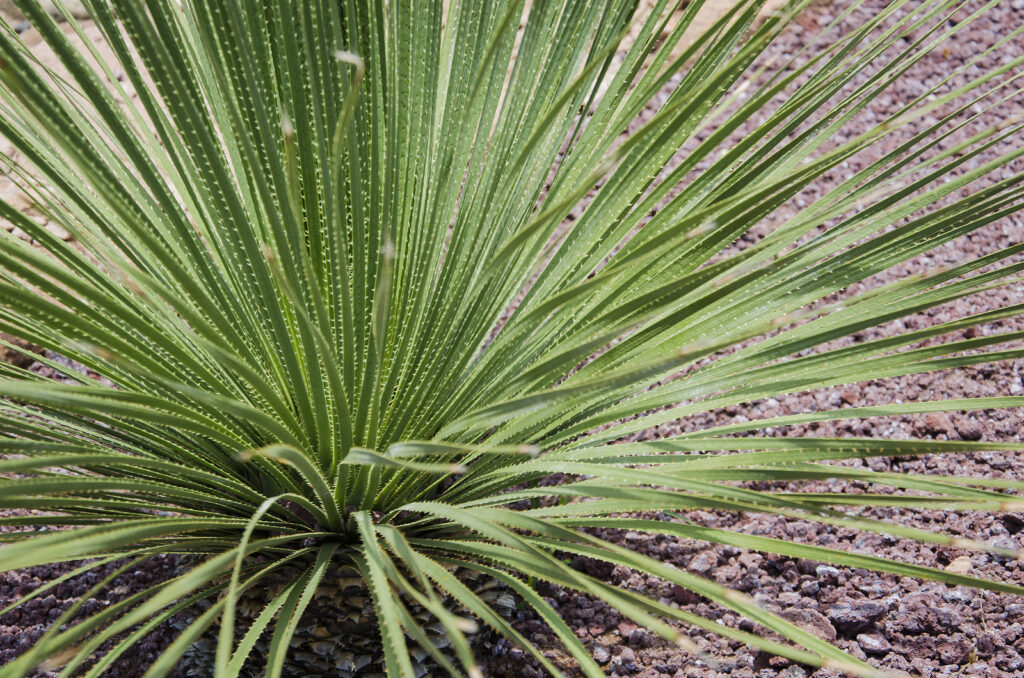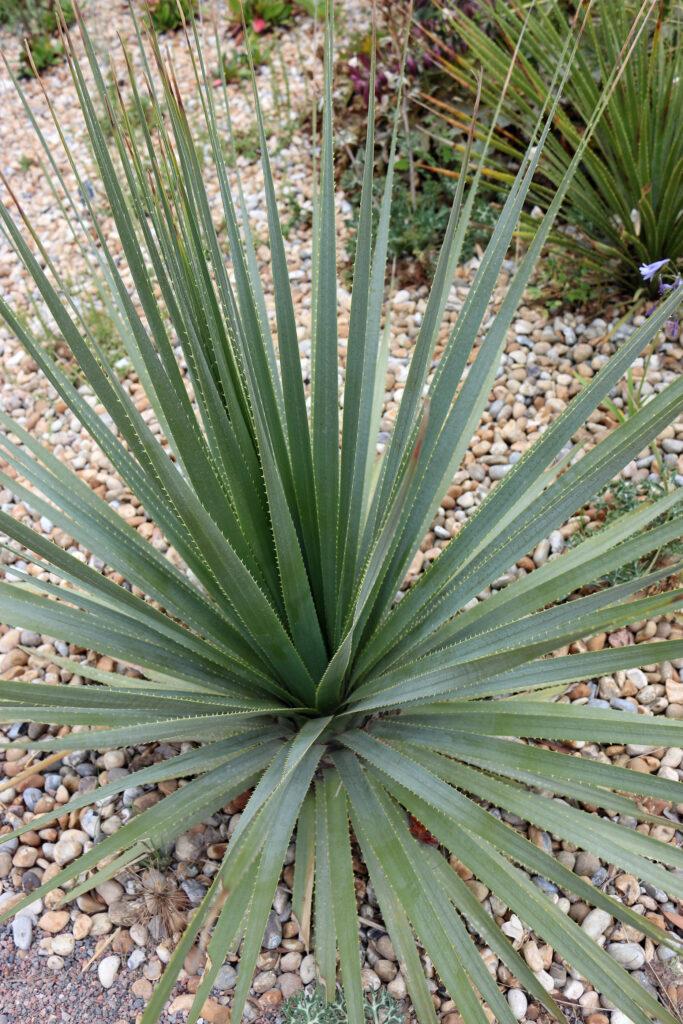Dasylirion is a genus of drought-tolerant, perennial plants native to the deserts of northern Mexico and the southwestern United States. These plants, commonly known as desert spoon or sotol, belong to the Asparagaceae family and are characterized by their striking, symmetrical rosettes of long, narrow, spiky leaves that radiate from a central base. The plants develop a trunk-like structure over time, and some species can eventually form a tall, tree-like appearance. Their leaves often have serrated edges, and many species produce tall flower spikes with small, cream-colored or whitish flowers.
Dasylirion is popular in xeriscaping and water-wise gardens due to its hardy nature and unique architectural beauty.
Overall, dasylirion is a low-maintenance plant that is perfect for beginner gardeners.

Dasylirion description
Dasylirion, also known as spoon yucca or desert spoon, is a drought-tolerant succulent plant native to North America. Dasylirion plants often have a rosette of long, sword-shaped leaves that are stiff and fibrous, giving them a unique appearance. They also produce tall flower stalks topped with clusters of small, bell-shaped flowers in various shades of white, pink, or purple.
The plants can range in size from small, compact rosettes to larger, tree-like forms. They produce tall flower spikes with small, bell-shaped flowers that attract pollinators like bees and hummingbirds. Dasylirion plants are prized for their unique appearance and ability to thrive in arid environments.
Dasylirion plants are well adapted to arid climates and are often used in xeriscaping and desert landscaping. They are low-maintenance and drought-tolerant, making them popular choices for gardeners looking for water-wise plants.
Where to plant Dasylirion
- Sunlight: Dasylirion thrives in full sun. It needs at least 6-8 hours of direct sunlight each day. In shadier areas, its growth may become slow or stunted.
- Space: These plants can grow quite large, so give them plenty of room to spread out. Depending on the species, the rosettes can reach several feet wide, and the flower spikes can tower up to 10 feet tall.
- Well-drained soil: Dasylirion prefers well-drained, sandy, or rocky soils. Heavy, water-retentive soils like clay can cause root rot. Amending your garden soil with gravel or coarse sand will help improve drainage. Well-draining soil is essential for dasylirion to prevent root rot. A sandy or cactus mix soil works well for this plant.
- pH Level: These plants do well in slightly acidic to neutral soils (pH 6.0–7.5), but they are highly adaptable to a variety of conditions.
When to plant Dasylirion
Plant Dasylirion in the spring or early fall when the weather is warm, but not too hot.
Planting Dasylirion
- Hole Size: Dig a hole that is twice as wide and just as deep as the plant’s root ball. If planting a potted Dasylirion, gently remove the plant from its container, being careful of the spiky leaves.
- Planting: Place the root ball in the hole and backfill it with a mix of native soil and a bit of gravel or sand for better drainage. Ensure the plant is level with the surrounding soil.
Watering Dasylirion
- Initial Watering: After planting, water the plant deeply to help establish its roots.
- Ongoing Watering: Dasylirion is extremely drought-tolerant, and once established, it needs minimal watering. During its first year, water it every couple of weeks, allowing the soil to dry out between waterings. Once established, water it only during prolonged dry periods, especially in the summer.
Feeding Dasylirion
- Fertilizing: Dasylirion typically does not need much fertilizer. A light application of a balanced, slow-release fertilizer in spring can encourage growth but isn’t necessary in nutrient-poor soils.
- Feed your Dasylirion plant with a balanced fertilizer diluted to half strength during the growing season (spring and summer) to promote healthy growth. Do not fertilize in winter.
- You can feed the plant with a low-nitrogen liquid fertilizer once or twice a year during the growing season.

Dasylirion care and pruning
- Pruning: With their sharp, dagger-like leaves, Dasylirion plants may need occasional pruning to remove dead or damaged leaves. Use caution when pruning to avoid getting cut by the sharp leaf tips.
- As the plant matures, the lower leaves may dry out and turn brown. These can be pruned away to maintain a neat appearance and prevent the build-up of dead leaves around the base.
- Trim off any dead or damaged leaves to keep the plant looking neat and tidy. Avoid over-pruning, as dasylirion does not require much maintenance.
- Remove dead or yellowing leaves from the base of the plant to promote airflow and prevent pest infestations. You can also trim the flower stalks once they have finished blooming.
- Mulching: Use gravel or small rocks as mulch around the base of the plant to help retain moisture and maintain soil temperature, but avoid organic mulches that retain too much moisture.
Container growing Dasylirion
- Dasylirion can be easily growin in a container. Be careful not to overwater plants.
- Dasylirion has a slow growth rate and does not require frequent repotting. Repot the plant only when it has outgrown its container or if the soil has become compacted.
- Repot your Dasylirion plant every 2-3 years to refresh the soil and provide more space for growth. Choose a pot with drainage holes and replant in well-draining soil.
Dasylirion flowering
- Dasylirion may produce a tall, woody flower spike that can grow several feet high. Flowering usually occurs after many years of growth, and the spike contains small, fragrant flowers that attract pollinators. After flowering, the spike can be cut back to tidy the plant’s appearance.
Dasylirion pests and diseases
- Dasylirion is generally pest-resistant, but it can sometimes be affected by scale insects or mealybugs. These can be treated with horticultural oil or insecticidal soap.
- Root rot can be a problem if the soil is too wet or does not drain properly, so it’s essential to avoid overwatering.
Dasylirion winter care
- Dasylirion is hardy to USDA zones 7-11, depending on the species. In cooler climates, some species may require protection during winter, particularly if temperatures drop below 20°F (-6°C). Covering the plant with a frost cloth can help protect it during freezing temperatures.
- In colder climates, protect your Dasylirion plants from frost by covering them with a blanket or moving them indoors during the winter months.
- Dasylirion plants prefer warm temperatures and can tolerate heat and drought. However, they are not cold-hardy and should be protected from frost. Bring your plant indoors during winter if temperatures drop below freezing.



